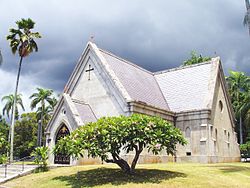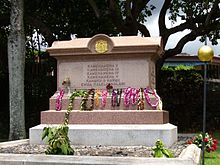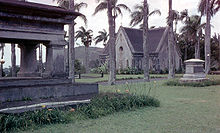- Royal Mausoleum of Hawaii
-
Royal MausoleumThe main building is now a chapel
Location: 2261 Nuʻuanu Ave., Honolulu, Hawaii Coordinates: 21°19′30″N 157°50′50″W / 21.325°N 157.84722°WCoordinates: 21°19′30″N 157°50′50″W / 21.325°N 157.84722°W Area: 4 acres (1.6 ha) Built: 1863 Architect: Theodore C. Heuck Architectural style: Gothic Governing body: State NRHP Reference#: 72000422[1] Added to NRHP: August 7, 1972 The Royal Mausoleum of Hawaii, known as Mauna ʻAla (Fragrant Hills) in the Hawaiian language, is the final resting place of Hawaii's two prominent royal families: the Kamehameha Dynasty and the Kalākaua Dynasty.[2]
Contents
Description
The site is located at 2261 Nuʻuanu Avenue in Honolulu, Hawaii on the island of Oahu, coordinates 21°19′30″N 157°50′50″W / 21.325°N 157.84722°W. The grounds of the mausoleum are surrounded by a black fence, bearing the royal seal of the Kingdom of Hawaii at the gate. A small chapel is located near the center, immediately behind the tomb of Kalākaua and his family, and to the right of the Kamehameha tomb, Bishop Monument, and Wyllie tomb. The chapel, in the shape of a Latin cross, is one of the few examples of Gothic Revival architecture in the islands.[3]
Construction
The 2.7 acre (11,000 m2) mausoleum was designed by architect Theodore Heuck. King Kamehameha IV and Queen Emma planned it as a burial site for their four-year old son, Prince Albert, who died on August 27, 1862. King Kamehameha IV became ill soon afterwards and died November 30, 1863, just 15 months after his son. His brother Lot Kamehameha came to the throne as King Kamehameha V.
Immediately Kamehameha V started construction of the mausoleum building. Construction was overseen by Thomas Nettleship Staley, first Anglican Bishop of Honolulu (1823–1898). The west ('Ewa) wing was completed at the end of January 1864. On February 3, 1864, a large funeral procession brought the body of Kamehameha IV from ʻIolani Palace near Kawaiahaʻo Church. His casket was placed on a casket stand in the new wing. Later in the evening they brought Ka Haku o Hawai'i (as Prince Albert was known) and laid him to rest alongside his father. Queen Emma was so overcome with grief that she camped on the grounds of Mauna ʻAla, and slept in the mausoleum.[2]
The mausoleum was completed in 1865, adjacent to the public 1844 Oahu Cemetery. The mausoleum seemed a fitting place to bury other past monarchs of the Kingdom of Hawaii and their families. The remains were transferred in a solemn ceremony leading from the burial vault called Pohukaina at ʻIolani Palace to the Nuʻuanu Valley on October 30, 1865.[2]
Robert Crichton Wyllie, Minister of Foreign Affairs, was buried here in October 1865.[3] Over time, the remains of almost all of Hawaii's monarchs, their consorts, and various princes and princesses would rest at the Royal Mausoleum. Kamehameha I and William Charles Lunalilo are the only two kings not resting at the mausoleum. William Charles Lunalilo, who preferred to be buried in a church cemetery, rests in the courtyard of Kawaiahaʻo Church. Princess Nāhiʻenaʻena and Queen Keōpūolani are buried on Maui at Waiola Church.
Kamehameha I's remains were hidden in a traditional practice to preserve the mana (power) of the aliʻi at the time of the Hawaiian religion.[2] For several generations, descendants of Hoʻolulu, one of the few chosen to help bury the remains of Kamehameha, have been appointed as caretakers.[4]
Mauna ʻAla was removed from the public lands of the United States by a joint resolution of Congress in 1900. It is the only place in Hawaii where the flag of Hawaii can officially fly alone without the American flag. In 1904 stucco was applied to the exterior, and original flooring covered. On June 24, 1910 the caskets from the Kalākaua family were moved to an underground vault excavated from rock.[5] In 1922 the main building was converted to a chapel, and the royal remains were moved to tombs constructed on the grounds. It was added to the National Register of Historic Places on August 7, 1972.[3]
See also
- List of burials in the Royal Mausoleum of Hawaii
- Thomas Nettleship Staley First Anglican Bishop of Honolulu
References
- ^ "National Register Information System". National Register of Historic Places. National Park Service. 2009-03-13. http://nrhp.focus.nps.gov/natreg/docs/All_Data.html.
- ^ a b c d William John Kaiheʻekai Maiʻoho (2003). "Nuʻuanu, Oʻahu - Memories: Mauna ʻAla". Pacific Worlds & Associates. http://www.pacificworlds.com/nuuanu/memories/memory1.cfm. Retrieved 2009-12-08.
- ^ a b c Dorothy Riconda (November 15, 1971). "The Royal Mausoleum nomination form". National Register of Historic Places. National Park Service. http://pdfhost.focus.nps.gov/docs/NRHP/Text/72000422.pdf. Retrieved 2009-10-13.
- ^ Sally Apgar (March 5, 2006). "Mai'ohos feel drawn to royal burial site Six generations have cared for the Nuuanu mausoleum for Hawaii's kings". Honolulu Star-Bulletin. http://archives.starbulletin.com/2006/03/05/news/story04.html.
- ^ Thomas G. Thrum (1911). "New Kalakau Dynasty Tomb". All about Hawaii: The recognized book of authentic information on Hawai (Honolulu Star-Bulletin). http://books.google.com/books?id=R-sKAAAAIAAJ&pg=RA1-PA105.
External links
- D. Thor Minnick (2002). "Mauna'ala:The Royal Mausoleum, Nu'uanu Valley, Oahu, Hawai'i". Minnick Associates. http://www.minnickassociates.com/projects/maunaala/maunaala.html. Retrieved 2009-10-13.
- Mauna ʻAla, Royal Mausoleum of Hawaii Photo Gallery
Protected Areas of Hawaii Federal Papahānaumokuākea Marine • World War II Valor in the PacificHakalau Forest • Hanalei • Hawaiian Islands • Huleia • James Campbell • Kakahaia • Kealia Pond • Kilauea Point • Kona Forest • Oahu ForestState Parks,
Monuments
Recreation Areas
and PreservesAkaka Falls State Park · Hapuna Beach State Recreation Area · Kalopa State Recreation Area · Kealakekua Bay State Historical Park · Kohala Historical Sites State Monument · Kona Coast (Kekaha Kai) State Park · Lapakahi State Historical Park · Lava Tree State Monument · MacKenzie State Recreation Area · Manuka State Wayside · Mauna Kea Ice Age Reserve · Mauna Kea State Recreation Area · Old Kona Airport State Recreation Area · Wailoa River State Recreation Area · Wailuku River State ParkKaua‘iMoloka‘iO‘ahuAhupua'a O Kahana State Park · 'Aiea Bay State Recreation Area · Diamond Head State Monument · Hanauma Bay Nature Preserve · He‘eia State Park · ‘Iolani Palace State Monument · Ka'ena Point State Park · Kaka'ako Waterfront Park · Kea'iwa Heiau State Recreation Area · Kewalo Basin · Kukaniloko Birthstones State Monument · La'ie Point State Wayside · Makapu‘u Point State Wayside · Malaekahana State Recreation Area · Nu'uanu Pali State Wayside · Pu'u o Mahuka Heiau State Monument · Pu'u 'Ualaka'a State Wayside · Royal Mausoleum State Monument · Sacred Falls State Park · Sand Island State Recreation Area · Ulu Pō Heiau State Monument · Wa'ahila Ridge State Recreation Area · Wahiawa Freshwater State Recreation AreaʻĀinahau · Brick Palace · Haleakalā · Halekamani · Haliʻimaile · Hanaiakamalama · Helumoa · Huliheʻe Palace · ʻIolani Palace · Kamakahonu · Kaniakapupu · Keōua Hale · Mokuʻula · Muolaulani · Paoakalani · Rooke House · Washington Place
Churches Mausolea Categories:- Royal Mausoleum of Hawaii
- Cemeteries in Hawaii
- Anglican cemeteries
- Government buildings on the National Register of Historic Places in Hawaii
- Protected areas of Oahu
- Buildings and structures in Honolulu, Hawaii
- Buildings and structures completed in 1865
- Buildings and structures on the National Register of Historic Places in Hawaii
- Protected areas established in 1900
Wikimedia Foundation. 2010.




